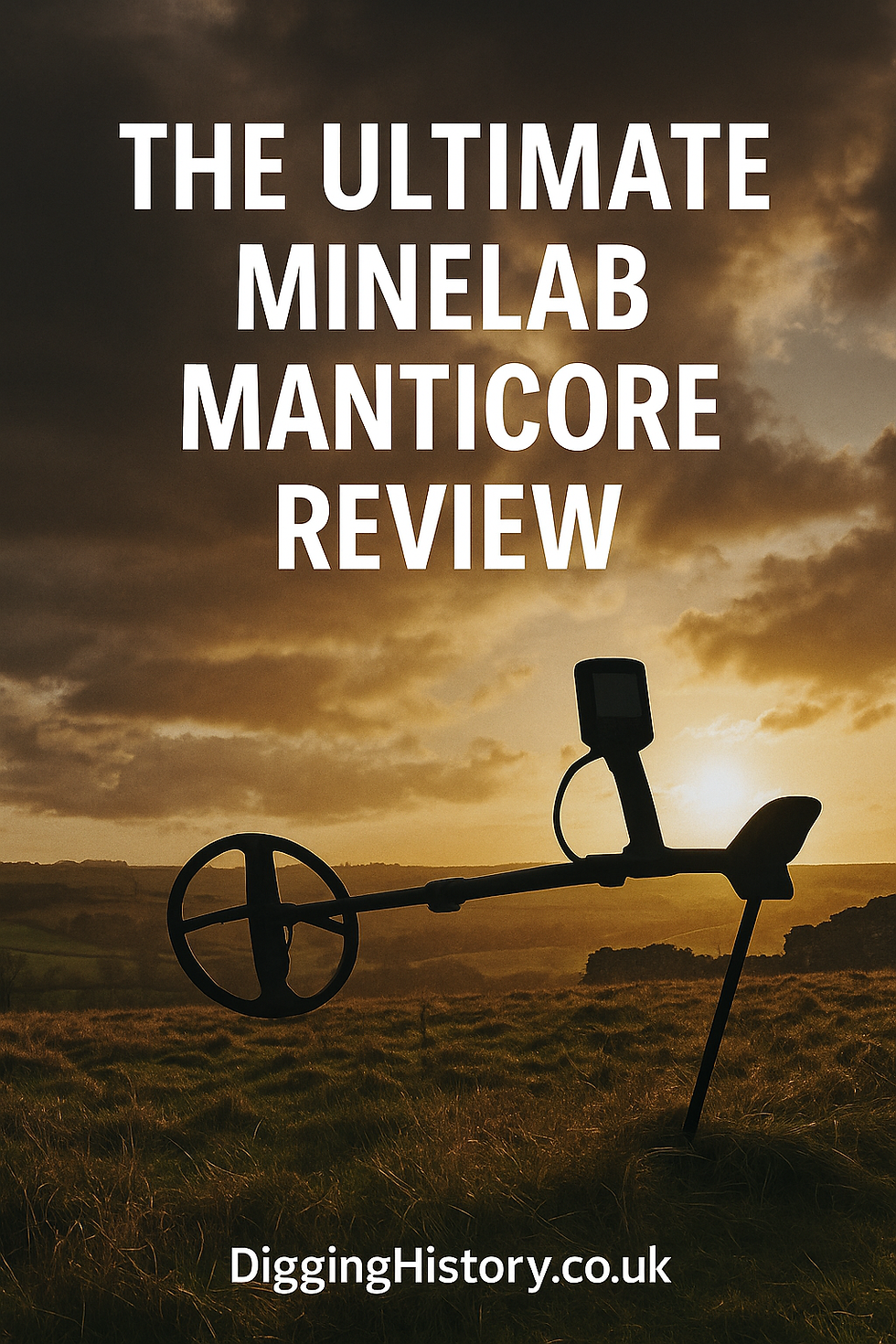Stuart & Civil War Britain (1600–1700) & Metal Detecting: The Ultimate Guide to Unearthing Treasure
- DiggingHistory.co.uk
- Sep 25
- 6 min read
Turmoil in Stuart Britain
The 17th century was one of Britain’s most turbulent eras. The Stuart dynasty began with James I in 1603, but within decades the kingdom descended into civil war between Charles I and Parliament (1642–1651). Armies clashed across the land, towns were besieged, and wealth was buried for safety, often never recovered.
For today’s detectorists, this turmoil makes the Stuart and Civil War period a golden age of finds. From hammered shillings, siege money, and Civil War hoards to musket balls, badges, rings, and everyday tokens, the 1600s left an extraordinary footprint in Britain’s soil.
This guide explores the artefacts, coins, and stories from Stuart Britain, focusing especially on the Civil War years, when more treasure was hidden than in almost any other English century.

Stuart Britain at a Glance (1600–1700)
1603 – James VI of Scotland becomes James I of England, uniting the crowns.
1625–1649 – Charles I rules; tensions rise with Parliament.
1642–1651 – English Civil War; monarchy temporarily abolished.
1649–1660 – Commonwealth under Oliver Cromwell.
1660 – Monarchy restored under Charles II.
1688 – Glorious Revolution; William and Mary take the throne.
1700 – Stuart era ends with wars abroad and political reform at home.
Coinage of the Stuart Century

James I (1603–1625)
Continued hammered coinage with shillings, sixpences, and gold unites.
Detectorist finds often include shillings with crowned portraits.
Charles I (1625–1649)
Hammered silver shillings and half-crowns were abundant.
During the Civil War, siege money was struck in besieged towns such as Newark, Scarborough, and Oxford. These emergency issues, often on silver plate, are prized detectorist finds.
Commonwealth & Cromwell (1649–1660)
The only English coins without a monarch’s portrait.
Commonwealth coinage bore plain shields and script.
Cromwell’s milled coins (1656–1658) are exceptionally rare finds.
Charles II (1660–1685)
Introduced fully milled coinage with mechanised presses.
Detectorists frequently uncover silver shillings, half-crowns, and early farthings.
William & Mary (1689–1702)
Joint coinage showed both monarchs’ busts.
Silver and copper denominations widely circulated.
Famous find: The Newark Civil War Hoard (1992) – over 5,000 silver coins buried during the Civil War, discovered by detectorists. It included siege money and rare issues from besieged towns.
Civil War Finds: Battlefields Beneath the Coil

The English Civil War left behind countless artefacts scattered across battlefields, camps, and towns. Many still surface in farmland today.
Musket Balls & Shot
Musket balls are the most common Civil War detecting find.
Flattened or distorted shot often indicates use in battle.
Pistol and carbine balls also appear in clusters near former skirmishes.
Weapon Fittings
Sword belt buckles, scabbard mounts, and spur fittings are regular detectorist finds.
Armour fragments (breastplate rivets, gauntlet plates) occasionally surface.
Military Badges & Personal Items
Lead badges depicting allegiances (e.g. royalist symbols).
Religious pendants and crucifixes carried by soldiers.
Pewter tankard lids or spoons lost in camp life.
Cannon Shot & Powder Flasks
Cannonballs or fragments sometimes appear near sieges.
Brass powder flask mounts occasionally survive.
Siege Money: Emergency Coinage of the Civil War
During sieges, besieged towns issued coins struck from silver plate and other metal. These are highly prized Civil War artefacts.
Newark – issued silver shillings and half-crowns stamped with “OBS” (for “obsessis,” Latin for “under siege”).
Scarborough & Oxford – issued small denominations.
Colchester & Carlisle – rare emergency issues.
Detectorists occasionally recover these crude but historic coins, often heavily worn.
Jewellery: Rings of Love, Loss & Loyalty

Despite war, personal jewellery was still worn and often lost.
Posy rings – gold bands inscribed with romantic mottos (“Let love continue”).
Mourning rings – commemorated the dead with initials or skull motifs.
Devotional pendants – crosses and religious medallions, some hidden during the Commonwealth.
Example: A detectorist in Oxfordshire uncovered a 17th-century gold posy ring inscribed with “Fear God and love me,” a poignant glimpse into Stuart romance.
Tokens, Seals & Everyday Artefacts

Trade Tokens
In the 17th century, shortages of small change led to local lead and copper tokens issued by traders.
These often carry initials, merchant marks, or symbols (e.g., a sheaf of wheat).
Detectorists find them widely, especially around former market towns.
Household Items
Keys, buckles, thimbles, spoons, and knife handles are common finds.
Pewter objects were widely used and frequently lost.
Weights & Watch Keys
Brass trade weights stamped with monarch’s marks.
Ornate watch keys from the rise of pocket watches.
Famous Stuart & Civil War Detectorist Finds
Newark Civil War Hoard (1992)
Over 5,000 silver coins, including siege money, buried during the Newark sieges. Found by detectorists, it remains one of the largest Civil War hoards.
Worcester Hoard (2008)
A detectorist found over 200 Civil War-era coins near the site of the Battle of Worcester (1651), marking the end of the wars.
Cromwell Gold Coins (various)
Occasional discoveries of Cromwell’s milled gold coins have been reported, rare but sensational when they surface.
Battlefield Clusters
Detectorists across Edgehill, Marston Moor, and Naseby (outside protected core zones) have reported musket ball clusters and soldier’s buckles, showing how conflict still echoes in the soil.
Detecting Stuart & Civil War Britain Landscapes
Battlefields
Edgehill (1642), Marston Moor (1644), Naseby (1645), Worcester (1651).
While core battlefield sites are often scheduled, surrounding farmland yields artefacts.
Siege Towns
Newark, Oxford, Scarborough, York.
Siege money, coin hoards, and musket balls turn up near these centres.
Manor Houses & Villages
Wealth was hidden during raids, often in pots or under floors.
Many hoards surface from rural fields where gentry estates once stood.
Trade Towns
Merchant tokens, seals, and everyday objects show bustling commerce.
Recognising Stuart & Civil War Finds
Coins: hammered shillings (James I, Charles I), siege money, Cromwell’s issues, early milled coins.
Musket Balls: round, flattened, or clustered.
Badges & Pendants: religious or allegiant symbols.
Rings: posy, mourning, devotional.
Tokens: lead or copper, merchant initials.
Everyday Objects: pewter spoons, thimbles, keys, buckles.
Laws & Responsible Detecting
England, Wales & NI – Treasure Act 1996
2+ coins over 300 years old = Treasure.
Gold/silver artefacts over 300 years old = Treasure.
Must report to coroner via FLO.
Scotland – Treasure Trove
All significant finds claimable by the Crown.
Report to the Treasure Trove Unit.
Best practice:
Always seek written landowner permission.
Avoid scheduled sites and protected battlefield cores.
Record finds with PAS or TTU.
What Stuart & Civil War Finds Teach Us
Coin hoards – wealth hidden during war, sometimes never recovered.
Musket balls & badges – traces of battlefield life and death.
Siege money – rare, localised emergency coinage.
Rings & jewellery – personal stories of love, faith, and loyalty.
Tokens & weights – daily trade and commerce in towns.
Practical Tips for Civil War Detecting
Research battle maps – artefacts often scatter in outer zones.
Focus on siege towns – Newark and Oxford produced siege money and hoards.
Expect musket balls – clusters may mark skirmishes or camps.
Look for merchant tokens – near market towns of the 1600s.
Check manorial lands – hoards were often buried near estates.
FAQs
Where are Civil War hoards most often found? Near besieged towns (Newark, Oxford, Scarborough) and battlefields like Worcester.
What is siege money? Emergency coinage struck in besieged towns from silver plate, often crudely stamped.
What’s the most common Civil War find? Musket balls, thousands are recovered every year by detectorists.
Are Civil War finds Treasure? Yes, coins and precious objects over 300 years old fall under the Treasure Act.
Conclusion: Muskets, Siege Coins & Buried Treasure
The Stuart and Civil War century was defined by upheaval. Kings were toppled, towns besieged, and wealth buried in fear. For detectorists, this means an extraordinary abundance of finds: siege money, Civil War hoards, musket balls, tokens, rings, and personal relics of soldiers and civilians alike.
Every musket ball or token is a fragment of this turbulent century, a tangible link to the people who lived, fought, and died in Britain’s 17th-century conflicts. Detect responsibly, record diligently, and help bring Stuart Britain’s treasures back into the light.
Thank You for Reading
Thank you for exploring the Stuart and Civil War era with us. From siege money and hoards to musket balls and tokens, every find brings this turbulent century back to life.
👉 If you enjoyed this guide, please share it with fellow detectorists, history lovers, and friends, together we can keep uncovering and preserving Britain’s hidden stories.





Comments